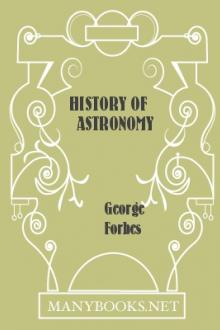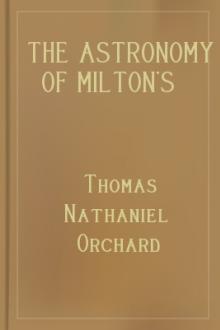History of Astronomy by George Forbes (classic children's novels TXT) 📕

- Author: George Forbes
- Performer: -
Book online «History of Astronomy by George Forbes (classic children's novels TXT) 📕». Author George Forbes
These and other discoveries in dynamics may seem very obvious now; but it is often the most every-day matters which have been found to elude the inquiries of ordinary minds, and it required a high order of intellect to unravel the truth and discard the stupid maxims scattered through the works of Aristotle and accepted on his authority. A blind worship of scientific authorities has often delayed the progress of human knowledge, just as too much “instruction” of a youth often ruins his “education.” Grant, in his history of Physical Astronomy, has well said that “the sagacity and skill which Galileo displays in resolving the phenomena of motion into their constituent elements, and hence deriving the original principles involved in them, will ever assure to him a distinguished place among those who have extended the domains of science.”
But it was work of a different kind that established Galileo’s popular reputation. In 1609 Galileo heard that a Dutch spectacle-maker had combined a pair of lenses so as to magnify distant objects. Working on this hint, he solved the same problem, first on paper and then in practice. So he came to make one of the first telescopes ever used in astronomy. No sooner had he turned it on the heavenly bodies than he was rewarded by such a shower of startling discoveries as forthwith made his name the best known in Europe. He found curious irregular black spots on the sun, revolving round it in twenty-seven days; hills and valleys on the moon; the planets showing discs of sensible size, not points like the fixed stars; Venus showing phases according to her position in relation to the sun; Jupiter accompanied by four moons; Saturn with appendages that he could not explain, but unlike the other planets; the Milky Way composed of a multitude of separate stars.
His fame flew over Europe like magic, and his discoveries were much discussed—and there were many who refused to believe. Cosmo de Medici induced him to migrate to Florence to carry on his observations. He was received by Paul V., the Pope, at Rome, to whom he explained his discoveries.
He thought that these discoveries proved the truth of the Copernican theory of the Earth’s motion; and he urged this view on friends and foes alike. Although in frequent correspondence with Kepler, he never alluded to the New Astronomy, and wrote to him extolling the virtue of epicycles. He loved to argue, never shirked an encounter with any number of disputants, and laughed as he broke down their arguments.
Through some strange course of events, not easy to follow, the Copernican theory, whose birth was welcomed by the Church, had now been taken up by certain anti-clerical agitators, and was opposed by the cardinals as well as by the dignitaries of the Reformed Church. Galileo—a good Catholic—got mixed up in these discussions, although on excellent terms with the Pope and his entourage. At last it came about that Galileo was summoned to appear at Rome, where he was charged with holding and teaching heretical opinions about the movement of the earth; and he then solemnly abjured these opinions. There has been much exaggeration and misstatement about his trial and punishment, and for a long time there was a great deal of bitterness shown on both sides. But the general verdict of the present day seems to be that, although Galileo himself was treated with consideration, the hostility of the Church to the views of Copernicus placed it in opposition also to the true Keplerian system, and this led to unprofitable controversies. From the time of Galileo onwards, for some time, opponents of religion included the theory of the Earth’s motion in their disputations, not so much for the love, or knowledge, of astronomy, as for the pleasure of putting the Church in the wrong. This created a great deal of bitterness and intolerance on both sides. Among the sufferers was Giordano Bruno, a learned speculative philosopher, who was condemned to be burnt at the stake.
Galileo died on Christmas Day, 1642—the day of Newton’s birth. The further consideration of the grand field of discovery opened out by Galileo with his telescopes must be now postponed, to avoid discontinuity in the history of the intellectual development of this period, which lay in the direction of dynamical, or physical, astronomy.
Until the time of Kepler no one seems to have conceived the idea of universal physical forces controlling terrestrial phenomena, and equally applicable to the heavenly bodies. The grand discovery by Kepler of the true relationship of the Sun to the Planets, and the telescopic discoveries of Galileo and of those who followed him, spread a spirit of inquiry and philosophic thought throughout Europe, and once more did astronomy rise in estimation; and the irresistible logic of its mathematical process of reasoning soon placed it in the position it has ever since occupied as the foremost of the exact sciences.
The practical application of this process of reasoning was enormously facilitated by the invention of logarithms by Napier. He was born at Merchistoun, near Edinburgh, in 1550, and died in 1617. By this system the tedious arithmetical operations necessary in astronomical calculations, especially those dealing with the trigonometrical functions of angles, were so much simplified that Laplace declared that by this invention the life-work of an astronomer was doubled.
Jeremiah Horrocks (born 1619, died 1641) was an ardent admirer of Tycho Brahe and Kepler, and was able to improve the Rudolphine tables so much that he foretold a transit of Venus, in 1639, which these tables failed to indicate, and was the only observer of it. His life was short, but he accomplished a great deal, and rightly ascribed the lunar inequality called evection to variations in the value of the eccentricity and in the direction of the line of apses, at the same time correctly assigning the disturbing force of the Sun as the cause. He discovered the errors in Jupiter’s calculated place, due to what we now know as the long inequality of Jupiter and Saturn, and measured with considerable accuracy the acceleration at that date of Jupiter’s mean motion, and indicated the retardation of Saturn’s mean motion.
Horrocks’ investigations, so far as they could be collected, were published posthumously in 1672, and seldom, if ever, has a man who lived only twenty-two years originated so much scientific knowledge.
At this period British science received a lasting impetus by the wise initiation of a much-abused man, Charles II., who founded the Royal Society of London, and also the Royal Observatory of Greeenwich, where he established Flamsteed as first Astronomer Royal, especially for lunar and stellar observations likely to be useful for navigation. At the same time the French Academy and the Paris Observatory were founded. All this within fourteen years, 1662-1675.
Meanwhile gravitation in general terms was being discussed by Hooke, Wren, Halley, and many others. All of these men felt a repugnance to accept the idea of a force acting across the empty void of space. Descartes (1596-1650) proposed an ethereal medium whirling round the sun with the planets, and having local whirls revolving with the satellites. As Delambre and Grant have said, this fiction only retarded the progress of pure science. It had no sort of relation to the more modern, but equally misleading, “nebular hypothesis.” While many were talking and guessing, a giant mind was needed at this stage to make things clear.
7. SIR ISAAC NEWTON—LAW OF UNIVERSAL GRAVITATION.
We now reach the period which is the culminating point of interest in the history of dynamical astronomy. Isaac Newton was born in 1642. Pemberton states that Newton, having quitted Cambridge to avoid the plague, was residing at Wolsthorpe, in Lincolnshire, where he had been born; that he was sitting one day in the garden, reflecting upon the force which prevents a planet from flying off at a tangent and which draws it to the sun, and upon the force which draws the moon to the earth; and that he saw in the case of the planets that the sun’s force must clearly be unequal at different distances, for the pull out of the tangential line in a minute is less for Jupiter than for Mars. He then saw that the pull of the earth on the moon would be less than for a nearer object. It is said that while thus meditating he saw an apple fall from a tree to the ground, and that this fact suggested the questions: Is the force that pulled that apple from the tree the same as the force which draws the moon to the earth? Does the attraction for both of them follow the same law as to distance as is given by the planetary motions round the sun? It has been stated that in this way the first conception of universal gravitation arose.[1]
Quite the most important event in the whole history of physical astronomy was the publication, in 1687, of Newton’s Principia (Philosophiae Naturalis Principia Mathematica). In this great work Newton started from the beginning of things, the laws of motion, and carried his argument, step by step, into every branch of physical astronomy; giving the physical meaning of Kepler’s three laws, and explaining, or indicating the explanation of, all the known heavenly motions and their irregularities; showing that all of these were included in his simple statement about the law of universal gravitation; and proceeding to deduce from that law new irregularities in the motions of the moon which had never been noticed, and to discover the oblate figure of the earth and the cause of the tides. These investigations occupied the best part of his life; but he wrote the whole of his great book in fifteen months.
Having developed and enunciated the true laws of motion, he was able to show that Kepler’s second law (that equal areas are described by the line from the planet to the sun in equal times) was only another way of saying that the centripetal force on a planet is always directed to the sun. Also that Kepler’s first law (elliptic orbits with the sun in one focus) was only another way of saying that the force urging a planet to the sun varies inversely as the square of the distance. Also (if these two be granted) it follows that Kepler’s third law is only another way of saying that the sun’s force on different planets (besides depending as above on distance) is proportional to their masses.
Having further proved the, for that day, wonderful proposition that, with the law of inverse squares, the attraction by the separate particles of a sphere of uniform density (or one composed of concentric spherical shells, each of uniform density) acts as if the whole mass were collected at the centre, he was able to express the meaning of Kepler’s laws in propositions which have been summarised as follows:—
The law of universal gravitation.—_Every particle of matter in the universe attracts every other particle with a force varying inversely as the square of the distance between them, and directly as the product of the masses of the two particles_.[2]
But Newton did not commit himself to the law until he had answered that question about the apple; and the above proposition now enabled him to deal with the Moon and the apple. Gravity makes a stone fall 16.1 feet in a second. The moon is 60 times farther from the earth’s centre than the stone, so it ought to be drawn out of a straight course through 16.1 feet in a minute. Newton found the distance through which she is actually drawn as a fraction of the earth’s diameter.





Comments (0)